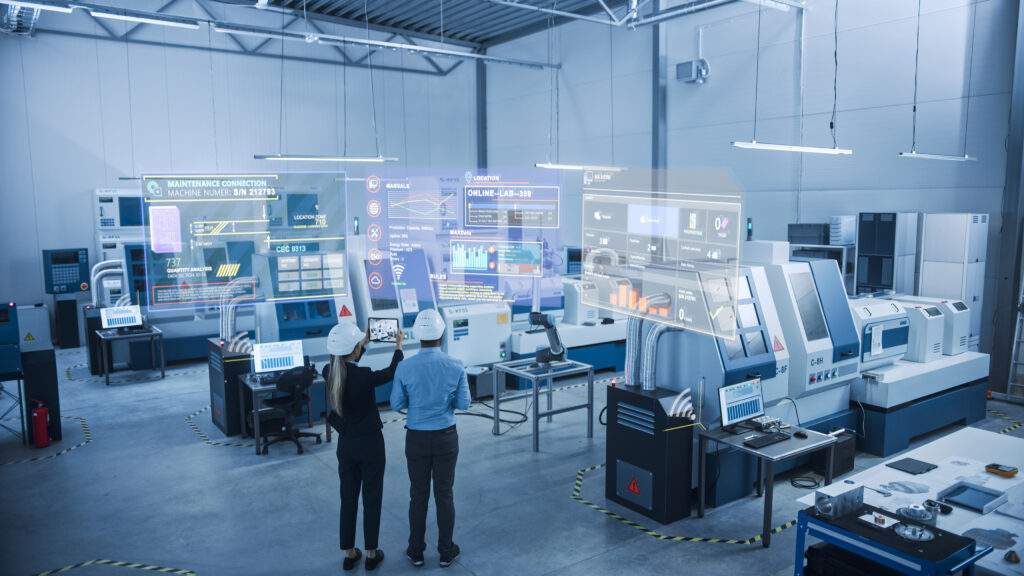
Jim Beretta, president of Customer Attraction, shares top automation trends for 2023
April 4, 2023
By Manufacturing AUTOMATION
Experts from the industrial automation space discuss technology trends that will impact manufacturers in 2023 and beyond.
 PHOTO: gorodenkoff / iStock / Getty Images Plus / Getty Images
PHOTO: gorodenkoff / iStock / Getty Images Plus / Getty Images Advances in automation technologies are transforming the industrial manufacturing landscape. Broadly termed “digital transformation,” these smart manufacturing initiatives bring physical and cyber systems together for greater performance, efficiency, sustainability and safety.
Automation experts share their predictions on trends that Canadian manufacturers need to watch out for in 2023 and respond to accordingly.
Here are the predictions for the year from Jim Beretta, president of Customer Attraction.
1. Labour has left the building
People are leaving the workforce in droves. They are retiring or are working in places other than manufacturing plants. Manufacturers used to have a choice. “How much is a robot” they would have asked in the past? Now manufacturers don’t have a choice. Cost is not that important. Automation and robots are their last hope of keeping that automation line working. In fact, I believe that automation helps attract and retain talent in today’s modern workforce. People (think Millennials and Gen Z) want to work for companies that invest in technology.
2. Humans will be part of the equation
Collaborative technology, that is robotics from companies like Kinova Robotics in Montreal, will grow and prosper. Cobots work well with humans and are a small part of the robotics market: less than five percent. But that market share is growing at a rapid pace. Collaborative technologies such as robots, conveyors and autonomous mobile robots, or AMRs, are simple and easy to use. Now they are plug-and-play, easy to program, connected to your phone and fast to integrate into discrete manufacturing operations such as packaging and palletizing, sanding or even welding. They allow small and medium enterprises to be flexible and to compete with the big guys. Cobots too can be a bridge technology to investing in faster and more complex automation systems.
3. Independent automation integration companies are disappearing
Mergers and acquisitions in the automation industry are at a fevered pace everywhere in North America. We have seen several established automation companies get purchased by large global players: RAMP, Systematix and Eclipse Automation in Waterloo Region alone in 2022! I have many friends that are retiring – those who worked in the industry for 35-years-retiring. Our knowledge base is shrinking fast. This, however, will open the door to entrepreneurs who want to start new shops and that is a good thing as competition in any industry is always good.
4. Robots are easy, automation is still hard
In The Robot Industry Podcast, I hear the words “high mix, low volume” in almost every single episode. Manufacturers and ultimately consumers want flexibility: flexible feeding, flexible picking, flexible labelling, flexible vision and flexible packaging and end-of-line systems. They want to be able to adjust quickly and on the fly. This makes designing automation really hard.
5. I can’t hear you!
Interoperability is hurting our industry and we don’t talk about it nearly enough. This massive problem (Brand X robot system not being able to talk to Brand Y robot systems) is slowing the industry and the robot and automation industry is a little too busy to notice. There are a bunch of companies that are trying to solve communication challenges and MassRobotics in Boston is leading the charge, looking to create a standard, hopefully, the standard.
6. RaaS will rule
RaaS or Robots-as-a-Service will continue to grow and thrive. Manufacturers are excited about the prospect of protecting their CAPEX and transferring the manufacturing costs to an operational expense model. RaaS sellers take care of everything: maintenance, advice, software upgrades and flexibility. A compelling concept is to expand the fleet at busy times, such as Christmas for distribution centres and shrink the fleet in January. Currently, autonomous robots (think Clearpath’s OTTO) and other brands such as Waypoint, MIR, Fetch and Locus are leading the way, but perhaps this model can move into Automation-Systems-as-a-Service or AaaS?
7. AI: Everywhere, all together, all at once.
Forgive me for (re) using the movie title but it really fits here. Artificial intelligence (AI) will be cheap; AI will be everywhere. AI will drive technologies like machine vision. This technology will be ubiquitous in a few years. Machines will be connected and will learn at a tremendous speed. Imagine if all the robots in all the Amazon plants shared data and were able to shave a fraction of a second off every pick, by sharing data and using AI. The manufacturers that are not collecting data will fall behind every year by just a few percentage points in key areas such as speed, quality, cost, uptime and waste.
8. Robots exploding into new sectors
Because labour has checked out, every other industry seems to have discovered or lost its fear of robots and automation. Construction, farming, consumer and food automation to name a few will be the new leaders in driving out cost and increasing quality and uptime by deploying robots and cobots.
9. Supply chain. Who knew?
Supply chain will still be a drag on the industry in 2023. Machine builders and customers will continue to scramble and force fit. They will change their design standards, they will overpay and will attempt to over-purchase, bulking up inventories like sensors and PLC devices. They will buy used robots and will continue to redesign mechanical systems to fit this new normal.
10. Cybersecurity
Sigh. We just aren’t moving quickly enough on protecting our data and we will continue to fall behind in implementing robust cybersecurity measures in manufacturing plants. Why? Because manufacturing wants to cut costs and the end customers will not pay for this overhead.
 Jim Beretta is president of Customer Attraction, an industrial marketing consultancy. He works with companies in robotics, automation, manufacturing, packaging and capital equipment on branding, marketing and search engine strategies.
Jim Beretta is president of Customer Attraction, an industrial marketing consultancy. He works with companies in robotics, automation, manufacturing, packaging and capital equipment on branding, marketing and search engine strategies.
He attended the University of Western Ontario and is based in Cambridge, Ont. Jim can be reached at jim@customerattraction.com.
Advertisement
- Webinar on real-time data in manufacturing airs live on April 27
- Report: Canadian manufacturing growth contracts in March